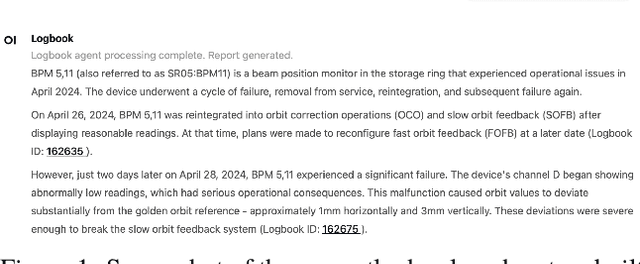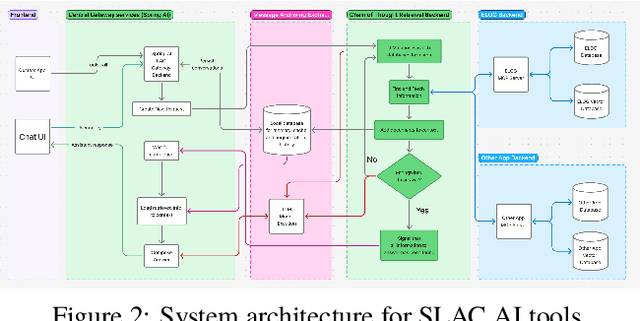Antonin Sulc
From Natural Language to Control Signals: A Conceptual Framework for Semantic Channel Finding in Complex Experimental Infrastructure
Dec 21, 2025Abstract:Modern experimental platforms such as particle accelerators, fusion devices, telescopes, and industrial process control systems expose tens to hundreds of thousands of control and diagnostic channels accumulated over decades of evolution. Operators and AI systems rely on informal expert knowledge, inconsistent naming conventions, and fragmented documentation to locate signals for monitoring, troubleshooting, and automated control, creating a persistent bottleneck for reliability, scalability, and language-model-driven interfaces. We formalize semantic channel finding-mapping natural-language intent to concrete control-system signals-as a general problem in complex experimental infrastructure, and introduce a four-paradigm framework to guide architecture selection across facility-specific data regimes. The paradigms span (i) direct in-context lookup over curated channel dictionaries, (ii) constrained hierarchical navigation through structured trees, (iii) interactive agent exploration using iterative reasoning and tool-based database queries, and (iv) ontology-grounded semantic search that decouples channel meaning from facility-specific naming conventions. We demonstrate each paradigm through proof-of-concept implementations at four operational facilities spanning two orders of magnitude in scale-from compact free-electron lasers to large synchrotron light sources-and diverse control-system architectures, from clean hierarchies to legacy environments. These implementations achieve 90-97% accuracy on expert-curated operational queries.
A Straightforward Pipeline for Targeted Entailment and Contradiction Detection
Aug 23, 2025Abstract:Finding the relationships between sentences in a document is crucial for tasks like fact-checking, argument mining, and text summarization. A key challenge is to identify which sentences act as premises or contradictions for a specific claim. Existing methods often face a trade-off: transformer attention mechanisms can identify salient textual connections but lack explicit semantic labels, while Natural Language Inference (NLI) models can classify relationships between sentence pairs but operate independently of contextual saliency. In this work, we introduce a method that combines the strengths of both approaches for a targeted analysis. Our pipeline first identifies candidate sentences that are contextually relevant to a user-selected target sentence by aggregating token-level attention scores. It then uses a pretrained NLI model to classify each candidate as a premise (entailment) or contradiction. By filtering NLI-identified relationships with attention-based saliency scores, our method efficiently isolates the most significant semantic relationships for any given claim in a text.
Alpha Berkeley: A Scalable Framework for the Orchestration of Agentic Systems
Aug 20, 2025Abstract:Coordinating workflows across heterogeneous control systems remains a central challenge in safety-critical environments such as scientific facilities, industrial plants, and energy infrastructures. Language-model-driven agents offer a natural interface for these tasks, but existing approaches often lack scalability, reliability, and human oversight. We introduce the Alpha Berkeley Framework, a production-ready architecture for scalable agentic systems that integrate conversational context with robust tool orchestration. The framework features dynamic capability classification to select only relevant tools per task, a plan-first orchestration model that generates execution plans with explicit dependencies and optional human approval, context-aware task extraction that combines dialogue history with external memory and domain resources, and production-ready execution environments with checkpointing, artifact management, and modular deployment. We demonstrate its versatility through two case studies: a tutorial-style wind farm monitoring example and a deployment at the Advanced Light Source particle accelerator. These results establish Alpha Berkeley as a reliable and transparent framework for agentic systems in high-stakes domains.
eLog analysis for accelerators: status and future outlook
Jun 15, 2025

Abstract:This work demonstrates electronic logbook (eLog) systems leveraging modern AI-driven information retrieval capabilities at the accelerator facilities of Fermilab, Jefferson Lab, Lawrence Berkeley National Laboratory (LBNL), SLAC National Accelerator Laboratory. We evaluate contemporary tools and methodologies for information retrieval with Retrieval Augmented Generation (RAGs), focusing on operational insights and integration with existing accelerator control systems. The study addresses challenges and proposes solutions for state-of-the-art eLog analysis through practical implementations, demonstrating applications and limitations. We present a framework for enhancing accelerator facility operations through improved information accessibility and knowledge management, which could potentially lead to more efficient operations.
Towards Agentic AI on Particle Accelerators
Sep 10, 2024Abstract:As particle accelerators grow in complexity, traditional control methods face increasing challenges in achieving optimal performance. This paper envisions a paradigm shift: a decentralized multi-agent framework for accelerator control, powered by Large Language Models (LLMs) and distributed among autonomous agents. We present a proposition of a self-improving decentralized system where intelligent agents handle high-level tasks and communication and each agent is specialized control individual accelerator components. This approach raises some questions: What are the future applications of AI in particle accelerators? How can we implement an autonomous complex system such as a particle accelerator where agents gradually improve through experience and human feedback? What are the implications of integrating a human-in-the-loop component for labeling operational data and providing expert guidance? We show two examples, where we demonstrate viability of such architecture.
Automated Anomaly Detection on European XFEL Klystrons
May 20, 2024Abstract:High-power multi-beam klystrons represent a key component to amplify RF to generate the accelerating field of the superconducting radio frequency (SRF) cavities at European XFEL. Exchanging these high-power components takes time and effort, thus it is necessary to minimize maintenance and downtime and at the same time maximize the device's operation. In an attempt to explore the behavior of klystrons using machine learning, we completed a series of experiments on our klystrons to determine various operational modes and conduct feature extraction and dimensionality reduction to extract the most valuable information about a normal operation. To analyze recorded data we used state-of-the-art data-driven learning techniques and recognized the most promising components that might help us better understand klystron operational states and identify early on possible faults or anomalies.
PACuna: Automated Fine-Tuning of Language Models for Particle Accelerators
Oct 29, 2023
Abstract:Navigating the landscape of particle accelerators has become increasingly challenging with recent surges in contributions. These intricate devices challenge comprehension, even within individual facilities. To address this, we introduce PACuna, a fine-tuned language model refined through publicly available accelerator resources like conferences, pre-prints, and books. We automated data collection and question generation to minimize expert involvement and make the data publicly available. PACuna demonstrates proficiency in addressing intricate accelerator questions, validated by experts. Our approach shows adapting language models to scientific domains by fine-tuning technical texts and auto-generated corpora capturing the latest developments can further produce pre-trained models to answer some intricate questions that commercially available assistants cannot and can serve as intelligent assistants for individual facilities.
Textual Analysis of ICALEPCS and IPAC Conference Proceedings: Revealing Research Trends, Topics, and Collaborations for Future Insights and Advanced Search
Oct 13, 2023



Abstract:In this paper, we show a textual analysis of past ICALEPCS and IPAC conference proceedings to gain insights into the research trends and topics discussed in the field. We use natural language processing techniques to extract meaningful information from the abstracts and papers of past conference proceedings. We extract topics to visualize and identify trends, analyze their evolution to identify emerging research directions, and highlight interesting publications based solely on their content with an analysis of their network. Additionally, we will provide an advanced search tool to better search the existing papers to prevent duplication and easier reference findings. Our analysis provides a comprehensive overview of the research landscape in the field and helps researchers and practitioners to better understand the state-of-the-art and identify areas for future research.
Towards Monocular Shape from Refraction
May 31, 2023Abstract:Refraction is a common physical phenomenon and has long been researched in computer vision. Objects imaged through a refractive object appear distorted in the image as a function of the shape of the interface between the media. This hinders many computer vision applications, but can be utilized for obtaining the geometry of the refractive interface. Previous approaches for refractive surface recovery largely relied on various priors or additional information like multiple images of the analyzed surface. In contrast, we claim that a simple energy function based on Snell's law enables the reconstruction of an arbitrary refractive surface geometry using just a single image and known background texture and geometry. In the case of a single point, Snell's law has two degrees of freedom, therefore to estimate a surface depth, we need additional information. We show that solving for an entire surface at once introduces implicit parameter-free spatial regularization and yields convincing results when an intelligent initial guess is provided. We demonstrate our approach through simulations and real-world experiments, where the reconstruction shows encouraging results in the single-frame monocular setting.
* 12 pages, 6 figures, The 32nd British Machine Vision Conference (BMVC)
 Add to Chrome
Add to Chrome Add to Firefox
Add to Firefox Add to Edge
Add to Edge